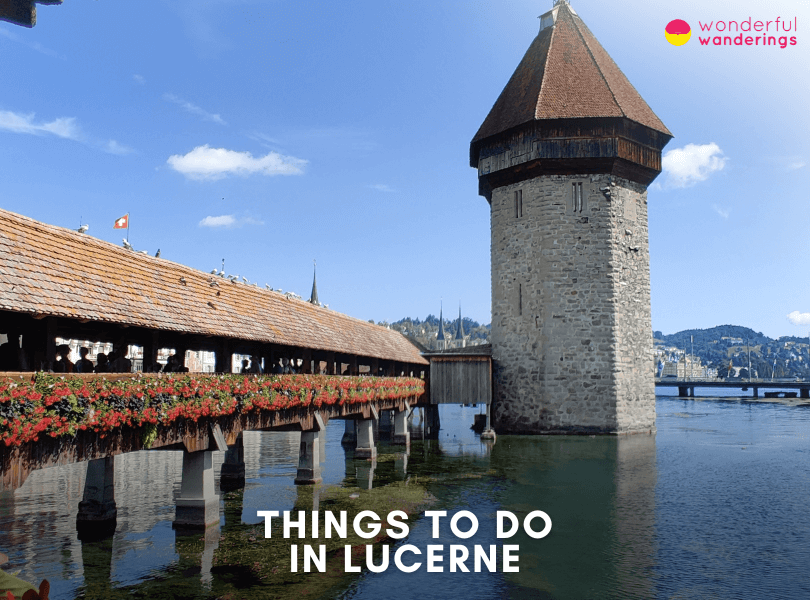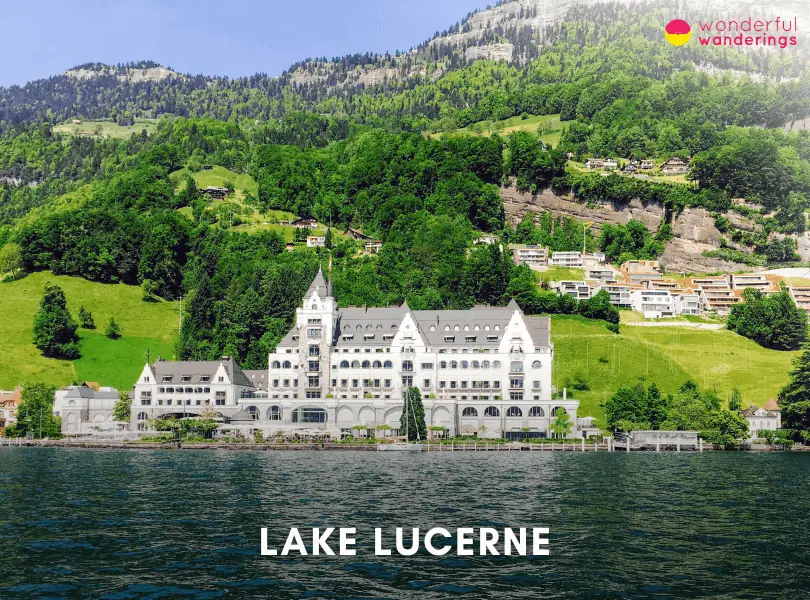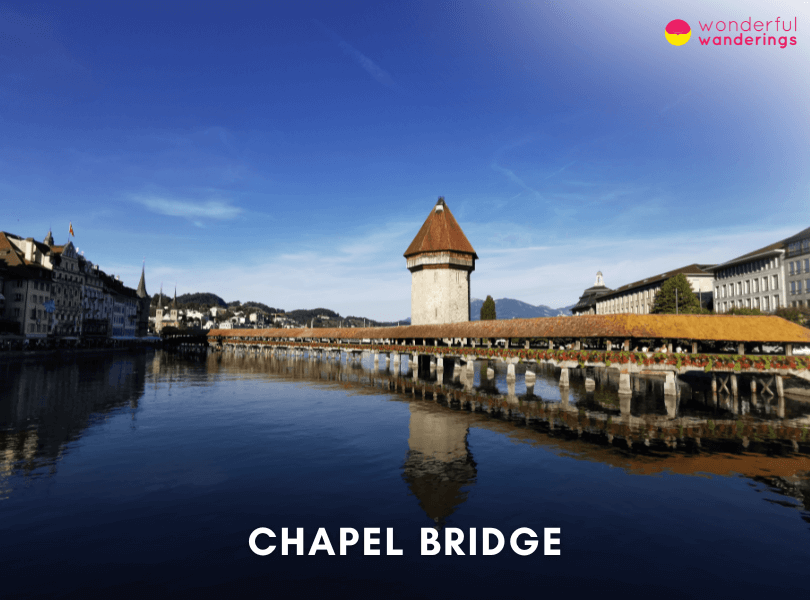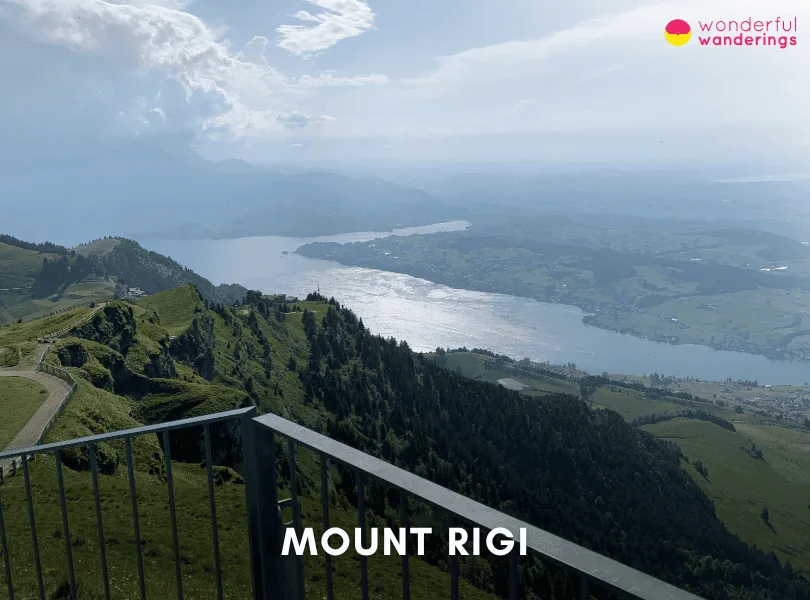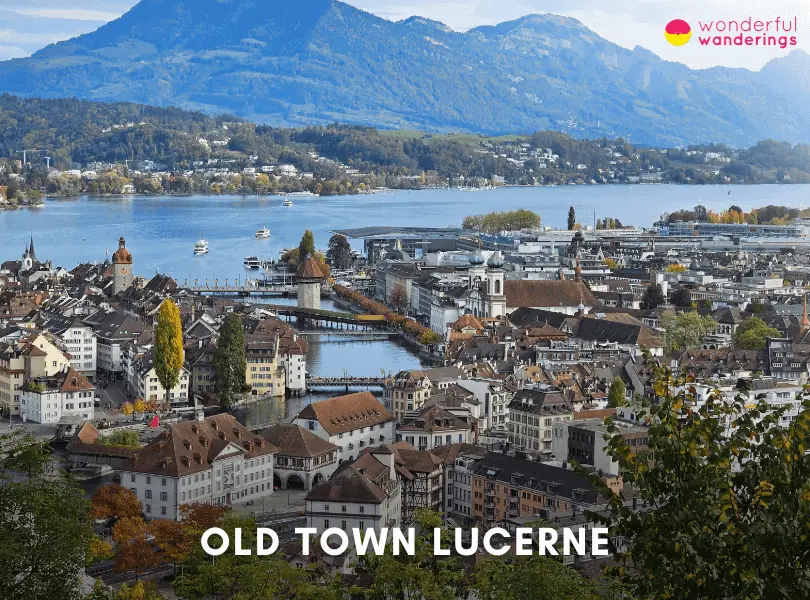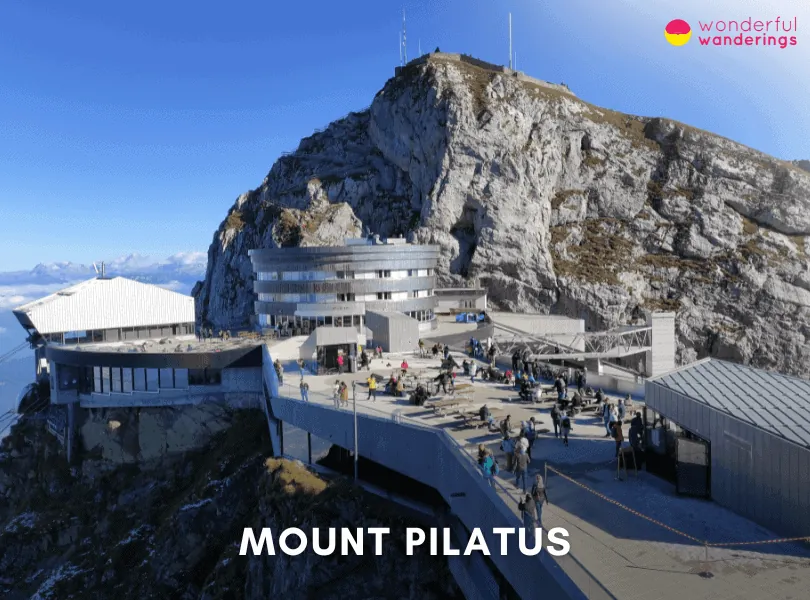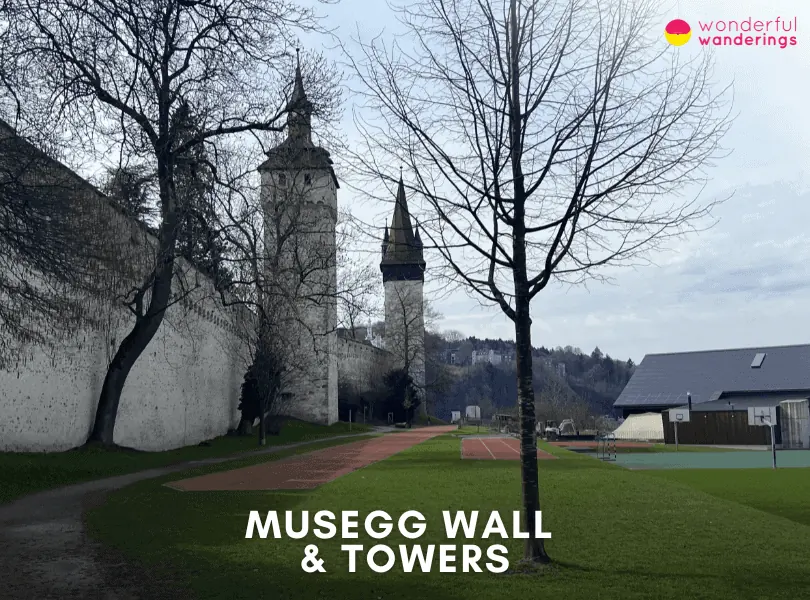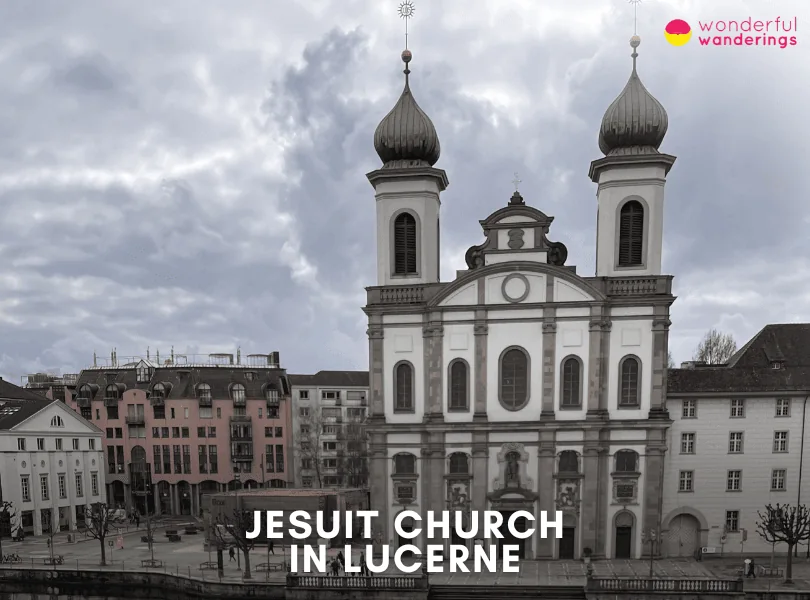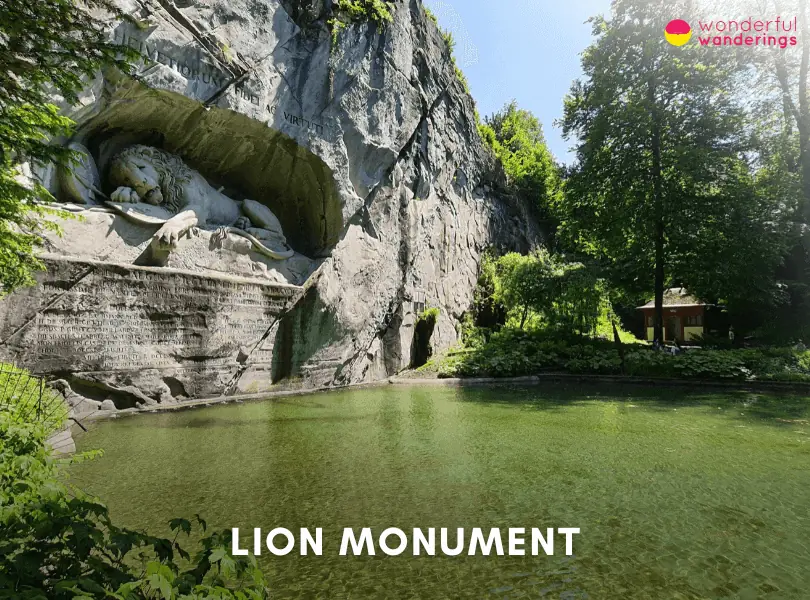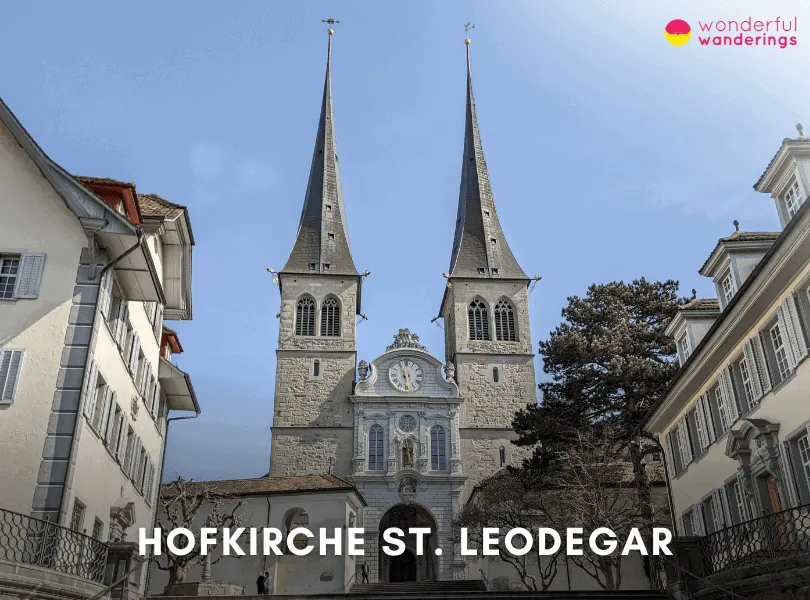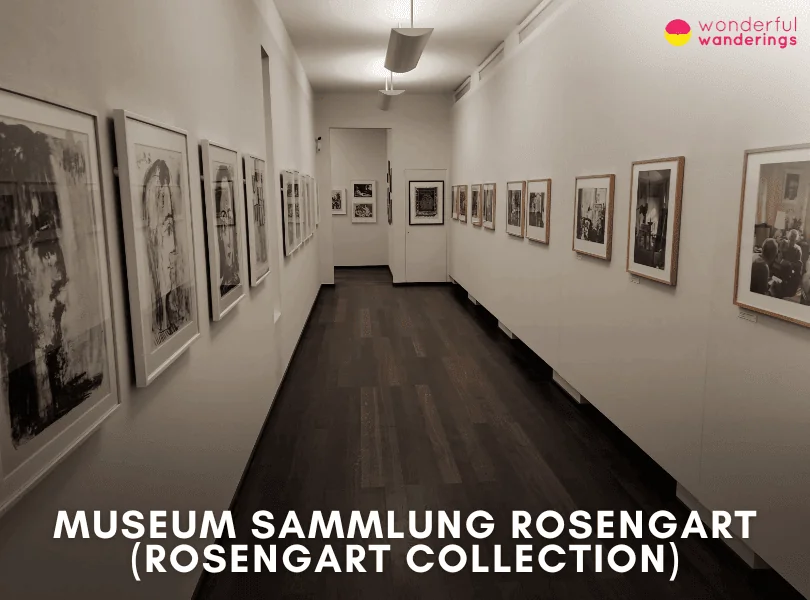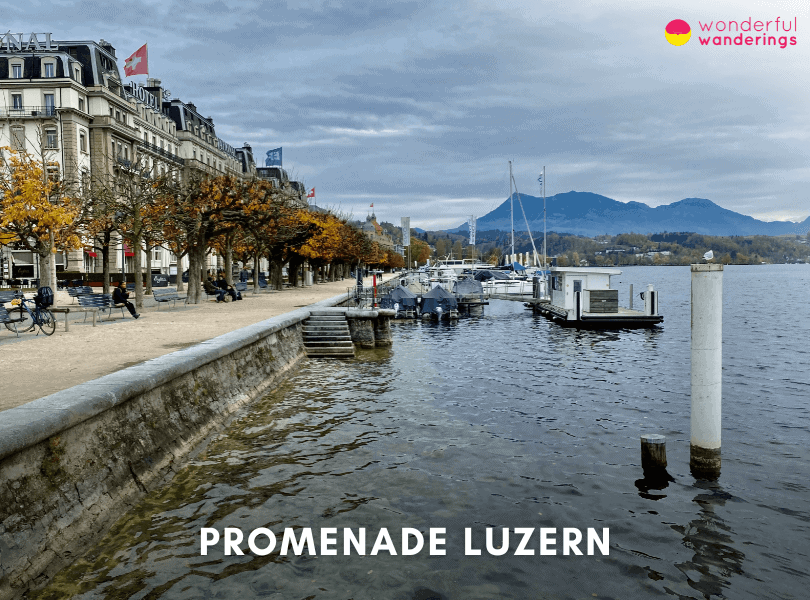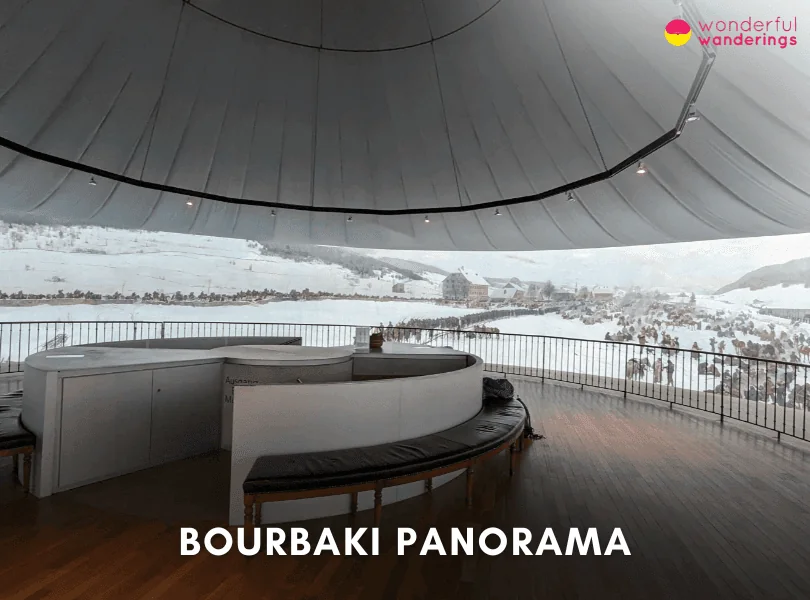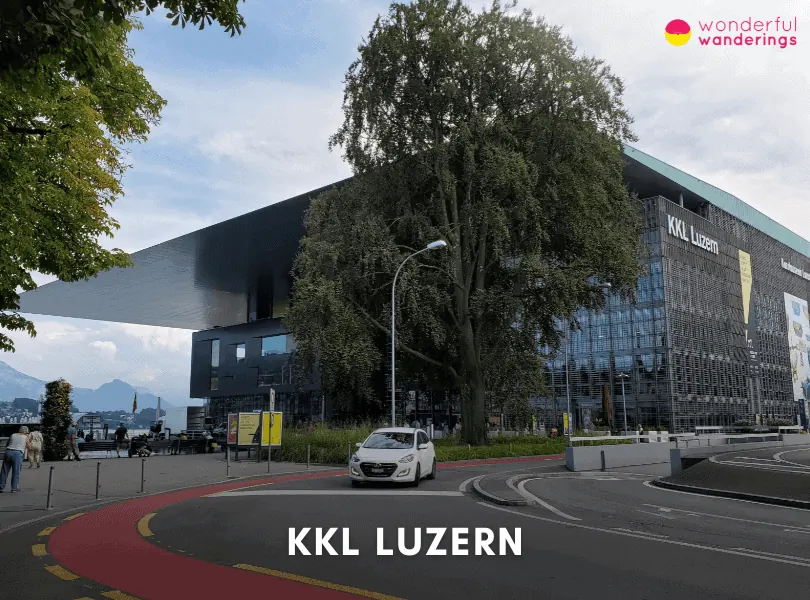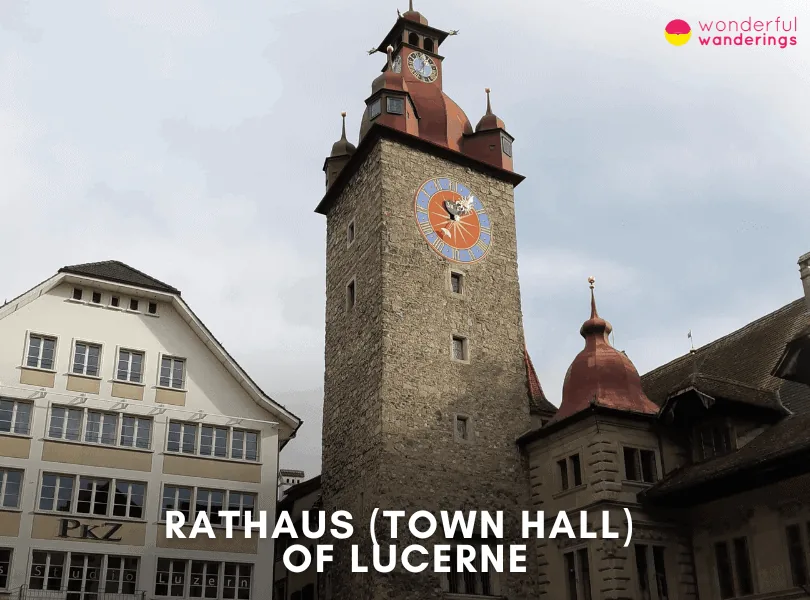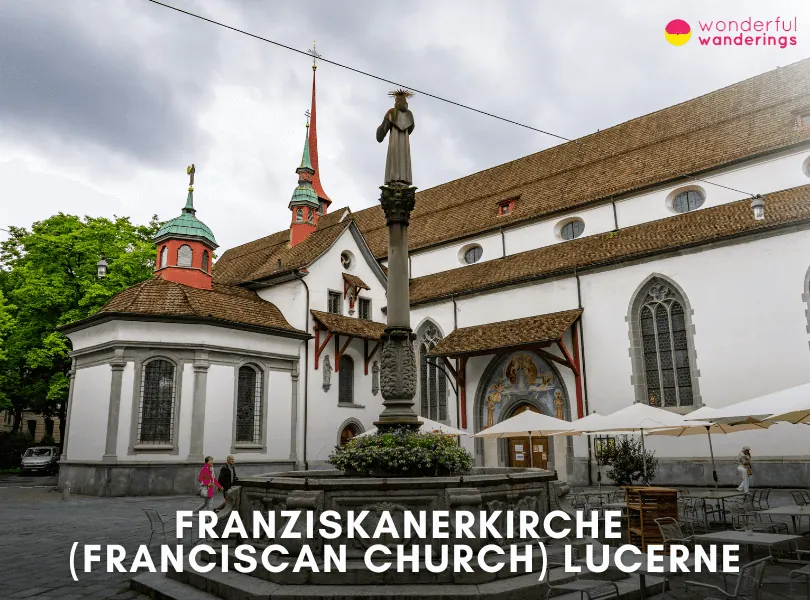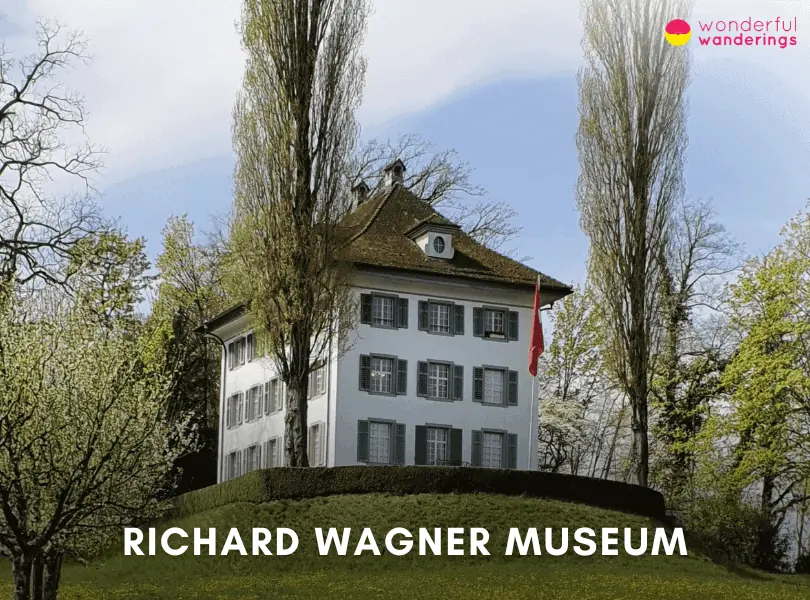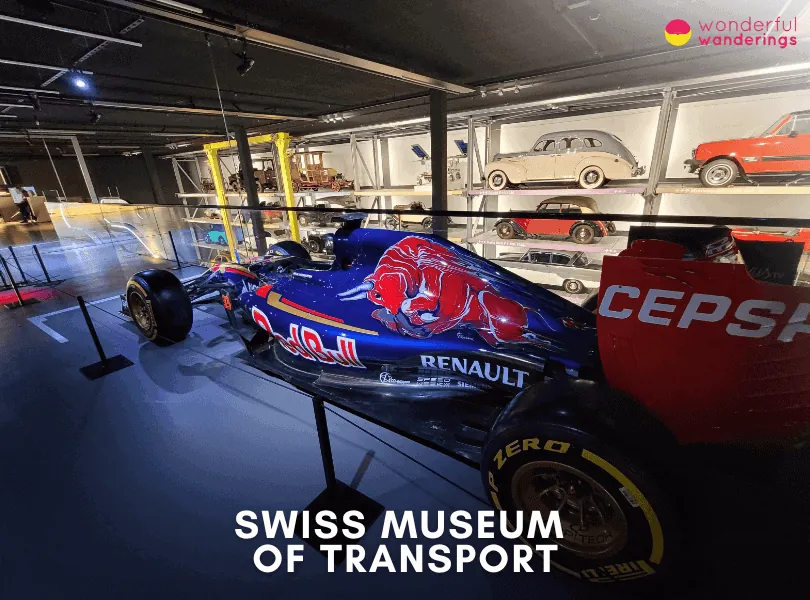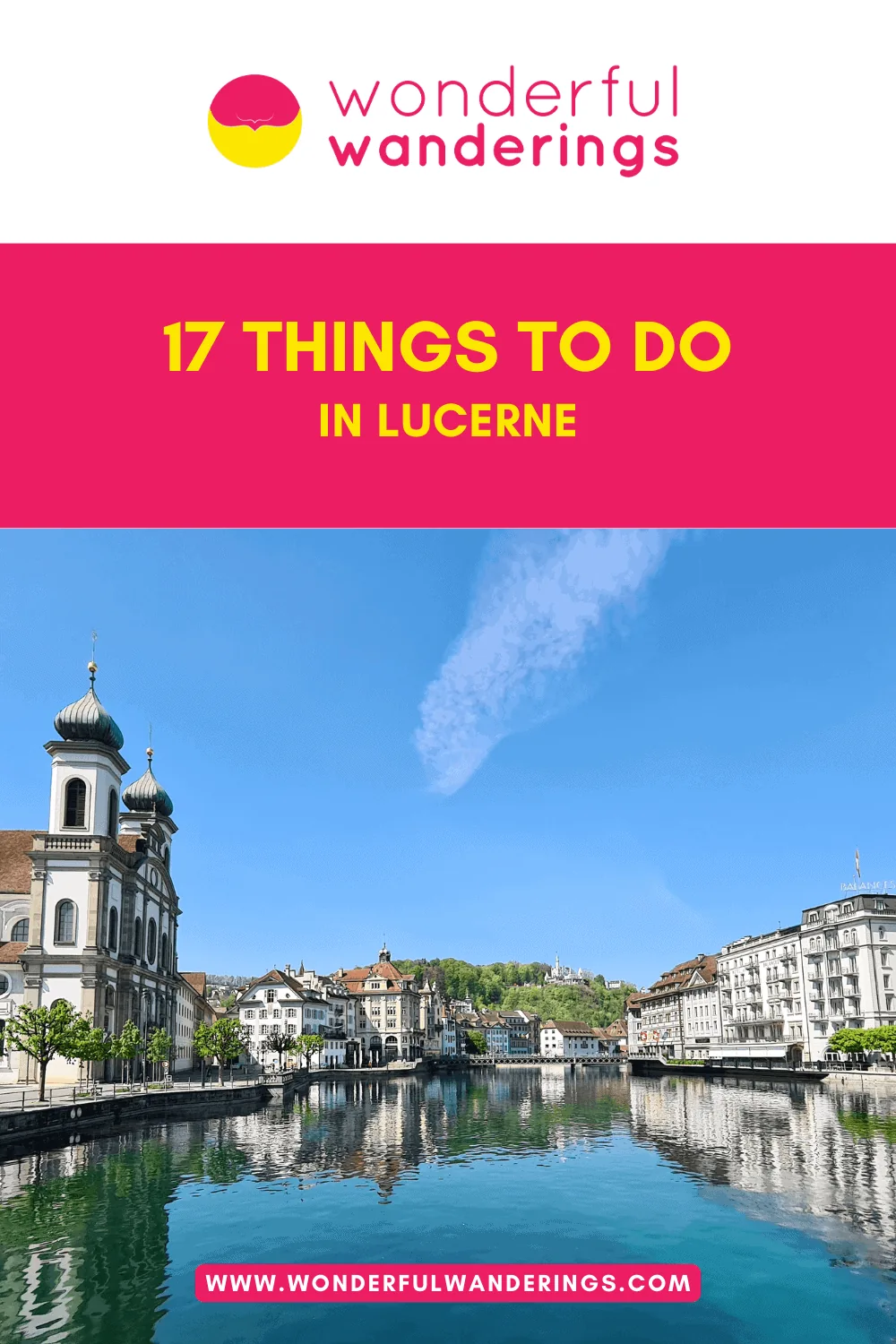Lucerne is in central Switzerland at the outfall of the Reuss River into Lake Lucerne. The city occupies both river banks and the lake’s lowest reach, with the city center straddling the river downstream. Lucerne is surrounded by mountains, with Mount Pilatus to the southwest and the Bernese Alps to the southeast across the lake. The city has a population of 85,197 as of 2023, making it the most populous city in the canton of Lucerne.
Lucerne grew out of a Benedictine monastery founded in the 8th century and became an important trade center after the opening of the Gotthard Pass in the 13th century. Lucerne joined an alliance with Uri, Schwyz and Unterwalden in 1332 to gain independence from the Habsburgs, later leading the Catholic cantons after the Reformation. Lucerne expanded its territory in the 15th century but lost political power after being defeated by Protestant forces in the Second War of Villmergen in 1712. Napoleon occupied it in 1798 before regaining its status as the capital of its canton. Lucerne thrived and now is a popular tourist destination known for its well-preserved medieval architecture.
Lucerne is a popular tourist destination known for attractions like its well-preserved 14th-century Chapel Bridge, the Lion Monument memorial, its mountain setting along Lake Lucerne and museums such as the Swiss Transport Museum. Other highlights include outdoor activities around peaks like Mount Pilatus, the cultural offerings of the Jean Nouvel-designed convention complex, Old Town’s cobblestone lanes and historic sites and cruises on Lake Lucerne to take in stunning Alpine vistas. Lucerne lies in the Central European Time zone, GMT/UTC +1, observing Daylight Saving Time in summer.Listed below are things to do in Lucerne.
- Lake Lucerne. Lake Lucerne is a lake surrounded by mountains in central Switzerland. It has a unique shape with several scenic bays and is 114 km² with a maximum depth of 214 meters. The lake is historically and culturally significant as one of the oldest settled areas of Switzerland. It offers visitors various activities like boat cruises, water sports, hiking and sightseeing.
- Chapel Bridge. The Chapel Bridge is a covered wooden footbridge in Lucerne, originally built in 1333, making it one of the oldest wooden bridges in Europe. It spans the Reuss River and connects the old and new town areas. The bridge is named for the nearby St. Peter’s Chapel and features historical paintings. Much of the bridge and paintings were destroyed in a 1993 fire but were restored. Visitors can walk across the bridge and explore the nearby Water Tower.
- Mount Rigi. Mount Rigi is a mountain peak between three lakes in central Switzerland, rising to 1,797 meters. It offers spectacular panoramic views and has a long history as a pioneering mountain tourism destination since the 19th century. The mountain has good accessibility and facilities. It offers a variety of summer and winter outdoor recreational activities like hiking, skiing and tobogganing. The mountain also has family-friendly attractions.
- Old Town Lucerne. The Old Town of Lucerne features well-preserved medieval architecture and cobblestone streets. Major landmarks include the Chapel Bridge, Water Tower and remnants of the Musegg Wall. Visitors can explore historical sites, shop at traditional stores and dine at local restaurants. The Old Town provides a glimpse into Lucerne’s past and Swiss cultural heritage. Its setting appeals to history, architecture enthusiasts and
visitors interested in Swiss Heritage. - Mount Pilatus. Mount Pilatus is a mountain near Lucerne steeped in legend and offering panoramic views. It can be accessed using a combination of cable cars and the world’s steepest cog railway. The mountain offers a range of activities like hiking, winter sports and scenic views. Its unique natural and cultural significance and adventure options appeal to diverse travelers. Admission costs vary depending on the chosen activities.
- Musegg Wall and Towers. The Musegg Wall and its nine towers are medieval fortifications built to defend Lucerne. Sections of the wall and towers are accessible to walk along and take in views of the city. The site provides glimpses of Lucerne’s history and habitats for rare plants and animals like bats and birds. The wall and towers offer an educational, outdoor experience well-suited for families with children and solo travelers. Admission is free and open seasonally.
- Jesuit Church in Lucerne. The Jesuit Church is an ornate Baroque church and a prominent religious landmark in Lucerne. Notable features include its white and gold Rococo decoration. As the first large Baroque church north of the Alps, it holds architectural and historical significance. Visitors can explore the decorative interiors and experience concerts in the fine acoustics. The church appeals to architecture enthusiasts, Catholics, history buffs and those interested in Swiss heritage.
- Lion Monument. The Lion Monument sculpture commemorates the heroic Swiss Guards killed in the 1792 French Revolution. Surrounded by trees, the monument and its inscription provide a contemplative space to reflect on themes of courage, duty and sacrifice. Its emotive impact and universal resonance make it an accessible destination for all visitors. There is no admission fee and the monument can be freely explored.
1. Lake Lucerne
Lake Lucerne, also known as Vierwaldstättersee, is in central Switzerland. It is surrounded by the three original Swiss cantons of Uri, Schwyz, Unterwalden and the canton of Lucerne. The lake has a total area of 114 km² and a maximum depth of 214 meters. It is a popular destination for native Swiss and foreigners, with many hotels and resorts along the shores. The lake is also historically significant, with many of the oldest communities of Switzerland located along its shore and it has been the site of archaeological findings dating back to around 1000 BC.
The lake is known for its unique shape and the variety of scenic bays, including the Bay of Lucerne, Bay of Gersau, Kreuztrichter, Bay of Weggis, Bay of Stans, Bay of Horw, Lake Alpnach, Lake Küssnacht and Lake Uri. Visitors to Lake Lucerne can enjoy various activities, including boat cruises, water sports, hiking and sightseeing. The lake is surrounded by picturesque mountains, such as Rigi and Pilatus, offering stunning views. There are also several historic sites and landmarks near the lake, including the meadow of the Rütli, the traditional site of the founding of the Swiss Confederation. The activities at Lake Lucerne cater to a wide range of visitors, including families, outdoor enthusiasts, history buffs and those interested in scenic landscapes.
The lake is easily accessible by train and road and regular steamer and passenger boat services connect the villages and towns along the lake. The lake has no admission cost, but entering specific attractions or participating in activities around Lake Lucerne may incur separate fees.
2. Chapel Bridge
The Chapel Bridge, also known as Kapellbrücke, is in Lucerne, Switzerland. It was originally constructed in 1333 and is one of the oldest wooden bridges in Europe. The bridge spans the Reuss River and is named after the nearby St. Peter’s Chapel. It is a significant historical and architectural landmark, forming a unique part of the town’s fortifications and connecting the old and new parts of the city. The bridge is also famous for the series of paintings that adorned it, depicting historical events and legends of Lucerne. The bridge suffered a devastating fire in 1993, which destroyed a large portion of the original paintings, but it was rebuilt and restored, reopening in 1994.
Visitors to the Chapel Bridge can stroll across the bridge, admiring the remaining paintings and the scenic views of the river and the surrounding area. There is also a Water Tower that can be explored. The Wasserturm Souvenir Shop in the Water Tower is open daily from 10 am to 6 pm. The Chapel Bridge is a family-friendly attraction suitable for visitors of all ages. Its historical significance and unique architecture make it an interesting destination for history enthusiasts, while the picturesque setting and the remaining paintings also appeal to art and photography enthusiasts.
Admission to the Chapel Bridge is free and visitors can enjoy a budget-friendly activity while exploring this iconic landmark. The bridge is open 24 hours a day, seven days a week, making it accessible to visitors anytime. The bridge is accessible on foot, approximately a 15-minute walk from the central Lucerne Train Station.
3. Mount Rigi
Mount Rigi, also known as the Queen of Mountains, is between Lakes Lucerne, Zug and Lauerz in central Switzerland. The highest point on the Rigi-Kulm at 1,797m asl offers a magnificent panorama over Lake Lucerne, the nearby Alps and the Swiss Plateau looking north. The mountain has a rich history, being a famous destination for travelers across Europe in the 18th century. It was the pioneer mountain of Alpine tourism and even attracted Queen Victoria, who was carried up the peak in a sedan chair. The modern era of tourism began in 1871 with the construction of the Vitznau-Rigi Railway, Europe’s first mountain railway and the Arth-Rigi Railway in 1875. The mountain is a popular destination for both summer and winter activities, offering many leisure activities and stunning views.
Visitors to Mount Rigi can enjoy various activities, including hiking, winter sports and leisurely experiences. The mountain offers skiing, snowboarding, tobogganing and winter hiking in winter, making it suitable for winter sports enthusiasts. In summer, it is a paradise for hikers, with over 120km of hiking paths and spectacular views over the lakes and the Swiss Plateau. Family activities include visiting Rigiland in Kaltbad, which features a large children’s playground. Mount Rigi suits are best for hikers, winter sports enthusiasts, families with children and those seeking leisurely experiences. The mountain’s varied offerings make it an ideal destination for people of all ages and interests.
The mountain is easily accessible by cog railway or cable car, with the Rigi railways carrying 600,000 passengers yearly. Visitors can also reach Mount Rigi from nearby cities such as Lucerne and Zurich, making it a convenient day trip destination. The admission cost for Mount Rigi may vary depending on the activities and facilities the visitors choose. The cost of using the Rigi railways or participating in specific winter or summer activities may have separate pricing. It is recommended to check the official website of Mount Rigi or contact local tourism offices for the most up-to-date information on admission and activity costs.
4. Old Town Lucerne
The Old Town of Lucerne or Altstadt, is a historic and picturesque area in Lucerne, Switzerland. It is renowned for its well-preserved medieval architecture and charming cobblestone streets. The Old Town of Lucerne has a rich history and cultural significance. It blends medieval, Renaissance and Baroque architecture, including the iconic Chapel Bridge (Kapellbrücke) and the Water Tower.
The Old Town Lucerne is also home to various historical landmarks, such as the Musegg Wall, a well-preserved remnant of the city’s medieval fortifications. The Old Town offers a glimpse into the city’s past and provides a charming setting for visitors to explore. Visitors to the Old Town of Lucerne can engage in various activities, including sightseeing, exploring historical sites, shopping at traditional Swiss stores and dining at local restaurants. The area is ideal for history enthusiasts, architecture aficionados and those interested in experiencing Switzerland’s cultural heritage. Families with children can also enjoy the Old Town’s unique atmosphere and educational opportunities.
The Old Town of Lucerne is easily accessible on foot from the city’s central areas. Visitors can also reach the Old Town via public transportation, as Lucerne has a well-connected network of buses and trains. Additionally, the city is a popular stop for river cruises on the Reuss River, providing another way for tourists to access the Old Town. The Old Town of Lucerne is an open area that does not require admission for entry. Visitors can freely explore the Old Town’s streets, squares and historical sites without incurring any entrance fees. Costs may be associated with specific attractions within the Old Town, such as museums or guided tours.
5. Mount Pilatus
Mount Pilatus is a prominent mountain massif in central Switzerland, near Lucerne. The mountain is known for its rich history and legendary status, with various myths and folklore associated with its name. It can be reached from Lucerne by combining gondola lift, aerial cable car and the world’s steepest rack-railway from Alpnachstad. The mountain offers many activities and experiences, making it a popular destination for tourists throughout the year.
Mount Pilatus has a legendary mystical reputation and stunning panoramic views of the Swiss Alps and Lake Lucerne. The mountain is steeped in folklore, with stories of a dragon, the burial place of a Roman governor and a petrified man guarding a cave. The mountain’s unique cultural and natural significance makes it a compelling destination for visitors seeking a blend of history, nature and adventure. Visitors to Mount Pilatus can engage in various activities, including hiking, tobogganing and enjoying the panoramic views from the various viewpoints. The mountain offers options for experiences and more adventurous pursuits, making it suitable for any visitors, including families, groups and individual travelers. The mountain is wheelchair accessible, allowing for inclusivity in its offerings.
The admission cost for Mount Pilatus may vary depending on the chosen activities and transportation methods. The cost of using the gondola lift, aerial cable car or rack railway may have separate pricing. Visitors should check the official website of Mount Pilatus or contact local tourism offices for the most up-to-date information on admission and activity costs.
6. Musegg Wall & Towers
The Musegg Wall and Towers are part of the historic fortifications of Lucerne, Switzerland. The wall and nine towers were built in the 14th century and are considered one of Switzerland’s longest and best-preserved defensive walls. The Musegg Wall and its towers offer a unique experience for visitors, providing a glimpse into the city’s medieval past and stunning views of Lucerne, its bay and the River Reuss.
Visitors to the Musegg Wall and Towers can walk along many sections of the ramparts, exploring the old natural stone walls and enjoying the habitat of endangered plants and animals, including rare breeding bird species such as jackdaws, common swifts and bats. The wall and towers are also home to specialized flora and fauna, making it an interesting destination for nature enthusiasts. The Musegg Wall and Towers also offer superb views of Lucerne City, its bay and the River Reuss, providing a setting for visitors to capture memorable moments and appreciate the city’s beauty. The Musegg Wall and Towers is best for children, families, solo travelers and couples. The experience is particularly well-suited for children aged 6 to 9, 10 to 13 and 14 and above, making it an inclusive destination for families with kids. The walls and towers offer children an educational and engaging experience, allowing them to learn about history, nature and the city’s fortifications while enjoying the outdoor setting. The Musegg Wall and Towers admission cost is free and open to the public. The wall and towers are open between April and November.
7. Jesuit Church in Lucerne
The Jesuit Church in Lucerne, Switzerland, is a significant Baroque masterpiece and a prominent religious and cultural site. The church is the first large Baroque church built north of the Alps and was constructed in the later half of the 17th century to bolster Catholicism’s presence amidst the Protestant church’s spread. The Jesuit Church is a stunning architectural gem, featuring a baroque facade and intricate interiors, including white and golden rococo stucco, frescoes and paintings depicting religious scenes. The church also offers fine acoustics, making it a splendid venue for classical and religious concerts.
Visitors to the Jesuit Church can explore its ornate interiors, including the grandiose rococo stucco ceiling, frescoes and religious paintings. The church is a remarkable place for architecture lovers, Catholics and typical tourists, offering an awe-inspiring and historically significant experience. The church’s fine acoustics also make it an ideal venue for those interested in attending concerts and experiencing the captivating transmission of melodies throughout the sanctuary. The Jesuit Church is ideal for architecture enthusiasts, Catholics, history buffs and those interested in experiencing Switzerland’s cultural and religious heritage. The church’s stunning architecture, religious significance and cultural impact make it a compelling destination for visitors of all ages and interests. Families, solo travelers and groups can all appreciate the beauty and historical importance of the Jesuit Church.
The church is at Jesuitenplatz, linked by Bahnhofstrasse from the train station, approximately half a kilometer from the Lucerne train station, making it easily accessible for visitors. Admission to the Jesuit Church is free and visitors can enter the church daily from 6:00 am until 6:30 pm. The church’s free entry and daily opening hours provide an accessible and inclusive experience for tourists and locals alike. It is recommended to download the church’s smartphone application, which provides insights into its architectural history and the latest visitor information and event details.
8. Lion Monument
The Lion Monument is in Lucerne, Switzerland. The monument is a significant historical landmark that commemorates the Swiss Guards who were massacred during the French Revolution in 1792. It is a powerful and moving piece of art that pays homage to the sacrifice and bravery of the Swiss Guards. The monument’s universal themes of sacrifice and remembrance make it an inclusive destination for visitors of all ages and backgrounds.
Visitors to the Lion Monument can explore its ornate interiors, including the grandiose rococo stucco ceiling, frescoes and religious paintings. The monument’s historical significance and emotional impact make it a compelling destination for tourists, history enthusiasts and those interested in Switzerland’s cultural heritage. The setting of the monument, surrounded by green trees and grass, adds to the contemplative and reflective atmosphere of the site. The Lion Monument is a remarkable place for architecture lovers, Catholics and typical tourists, offering an awe-inspiring and historically significant experience. The monument’s fine acoustics also make it an ideal venue for those interested in attending concerts and experiencing the captivating transmission of melodies throughout the sanctuary. The Lion Monument is ideal for architecture enthusiasts, Catholics, history buffs and those interested in experiencing Switzerland’s cultural and religious heritage. The monument’s stunning architecture, religious significance and cultural impact make it a compelling destination for visitors of all ages and interests. Families, solo travelers and groups can all appreciate the beauty and historical importance of the Lion Monument.
Admission to the Lion Monument is free and visitors can access the site without any entrance fees. The monument is open to the public and provides an accessible and inclusive experience for tourists and locals. It is advisable to check the latest visitor information and any additional guidelines or regulations that may be in place.
9. Hofkirche St. Leodegar
The Hofkirche St. Leodegar, also known as the Church of St. Leodegar, is a significant religious and historical site located in Lucerne, Switzerland. The church has a rich history, dating back to the 8th century when a monastery was founded on the site. The current structure, a combination of German Renaissance and Gothic architecture, was built between 1634 and 1645, with the mighty towers dating from the preceding Gothic-era building. The church is the oldest parish in the city and is known for its opulent décor and interior features, including the famous Hoforgel, a nearly 6,000-pipe organ that was once the largest in Europe.
Visitors to the Hofkirche St. Leodegar can immerse themselves in the church’s rich history and architectural beauty. The combination of German Renaissance and Gothic styles, the opulent interior and the impressive organ make the church a unique and visually stunning destination. The church is also a place of worship and a venue for classical and religious concerts, offering visitors a serene and contemplative atmosphere. The Hofkirche St. Leodegar is best suited for a diverse audience, including architecture enthusiasts, history buffs and visitors interested in experiencing Switzerland’s cultural and religious heritage. Families, solo travelers and groups can all appreciate the beauty and historical importance of the Hofkirche St. Leodegar.
Visitors can easily walk to the church from various locations within Lucerne. The church is also accessible by public transportation, with bus lines #1, #6, #19 and #73 stopping at the Luzernerhof bus stop, which is less than a minute’s walk from the church. The prominent spires of the church make it easily recognizable from various vantage points in the city, aiding in navigation for those on foot. Admission to the Hofkirche St. Leodegar is free and visitors can access the church without any entrance fees. The church is open to the public during specific hours, providing an accessible and inclusive experience for tourists and locals alike.
10. Museum Sammlung Rosengart (Rosengart Collection)
The Museum Sammlung Rosengart, also known as the Rosengart Collection, is an art museum located in Lucerne, Switzerland. The museum is at Pilatusstrasse 10, 6003 Luzern, making it easily accessible within the city. The collection is of great importance because it houses two unique groups of works by Paul Klee and Pablo Picasso. In addition, the collection exhibits works by over 20 masters of the 19th and 20th centuries, including Cézanne, Monet and Matisse. The museum was established in 2002 and is housed in the former premises of the Swiss National Bank, a neo-classical building dating from 1924. The museum is open daily, with extended hours during the summer months and is fully accessible, including wheelchair accessibility.
The Museum of Sammlung Rosengart offers a unique opportunity for visitors to immerse themselves in the artistic legacies of these two influential artists. The collection includes over 300 works of art by 23 artists of the so-called Classical Modernist Period, making it a significant cultural and historical resource. Visitors to the Museum Sammlung Rosengart can explore the extensive collection of modern art, including works by Paul Klee, Pablo Picasso and other masters of the 19th and 20th centuries. The museum offers an inspiring experience for art enthusiasts, history buffs and individuals interested in Switzerland’s cultural heritage. The museum’s diverse collection and the unique opportunity to view works by Klee and Picasso make it an inclusive destination for visitors of all ages and interests. Families, individuals and groups can all appreciate the beauty and historical importance of the Museum Sammlung Rosengart.
Visitors can easily walk to the Museum Sammlung Rosengart from various locations within Lucerne to get to the museum. The museum is also accessible by public transportation, with bus lines stopping nearby. The prominent location of the museum and its accessibility make it a convenient and inclusive destination for tourists and locals. The admission to the Museum Sammlung Rosengart is CHF 18 (€19, $21, £16) for adults and CHF 10 (€10, $11, £10) for students and seniors. Children under 16 years of age can enter the museum for free. The museum also offers guided tours for an additional fee.
11. Promenade Luzern
The Promenade Luzern is a lakeside walkway located in Lucerne, Switzerland. It stretches along the shores of Lake Lucerne, offering stunning views of the water and the surrounding mountains. The promenade is a popular destination for tourists and locals, providing a scenic setting for strolls and relaxation. The walkway is lined with trees and benches, creating an atmosphere for visitors to enjoy the natural beauty of the lake and its surroundings.
Visitors to the Promenade Luzern can engage in various activities, including walks and picnics and simply enjoy the lake setting. The walkway is an ideal destination for individuals and families seeking a peaceful and scenic environment to unwind and appreciate the natural beauty of the lake and its surroundings. The promenade is best for outdoor enthusiasts, families, couples and solo travelers who can all appreciate the beauty of the promenade, making it a popular choice for locals and tourists.
The Promenade Luzern is easily accessible on foot from various locations within Lucerne. The walkway is also conveniently located near the city center, allowing visitors to combine their visit with other nearby attractions and amenities. The promenade’s central location and accessibility make it a convenient and inclusive destination for tourists and locals alike. There is no admission cost for entering the Promenade Luzern, as it is a public walkway that is freely accessible to all visitors. The promenade is a popular and welcoming destination for visitors and families looking to experience the natural beauty of Lake Lucerne.
12. Bourbaki Panorama
The Bourbaki Panorama is a historical attraction in Lucerne, Switzerland. The circular painting, 114 meters around and 10 meters high, was painted in 1881 by Edouard Castres. It depicts a major military event in 1871, where 87,000 defeated French soldiers crossed the border into Switzerland, fleeing the Prussians. The government and the public disarmed and looked after the soldiers, giving rise to a humanitarian tradition. The museum offers a state-of-the-art exhibition and film that provides a deeper understanding of the historical event behind the painting. The museum also offers interactive stations, a panoramic film and original memorabilia, providing a tangible idea of the events. The Bourbaki Panorama is a symbol of Switzerland’s humanitarian tradition and a significant cultural monument in Europe.
Visitors to the Bourbaki Panorama can experience a unique and immersive journey into the historical event 1871. The circular painting and the accompanying exhibition offer a compelling and inspiring experience for history enthusiasts, individuals interested in the cultural heritage of Switzerland and those seeking a deeper understanding of humanitarian traditions. The museum’s diverse collection and the unique opportunity to view the panoramic paintings make it an inclusive destination for visitors of all ages and interests. Families, individuals and groups can all appreciate the historical importance of the Bourbaki Panorama. The museum’s extensive collection and the unique opportunity to view the panoramic paintings make it a compelling destination for visitors of all ages and interests.
Visitors can easily walk to the Bourbaki Panorama from various locations within Lucerne to get to the Bourbaki Panorama. The museum is also accessible by public transportation, with bus lines stopping nearby. Admission to the Bourbaki Panorama costs CHF 15 (€15, $17, £13). The museum offers special admission fees for groups, generation tickets and school classes. Visitors can benefit from various discounts, such as the Visitors Card Luzern/Tell-Pass, which offers a 20% discount on individual entrance fees.
13. KKL Luzern
The KKL Luzern, short for Kultur- und Kongresszentrum Luzern, is a renowned cultural and convention center in Lucerne, Switzerland. The KKL Luzern was designed by the French architect Jean Nouvel and the Swiss architect Roger Diener. It was inaugurated in 1998 and has since become an architectural landmark in Lucerne. The center is known for its exceptional acoustics and state-of-the-art facilities, including the Concert Hall, the Convention Center and the Museum of Art.
The KKL Luzern is renowned for its exceptional acoustics, particularly in the Concert Hall, which has made it a favored venue for musical performances and events. The center’s commitment to promoting arts, culture and intellectual exchange makes it a significant cultural institution in Switzerland. Visitors to the KKL Luzern can experience various cultural and artistic events, including classical and contemporary music concerts, art exhibitions and conventions. The center offers a compelling and inspiring experience for music enthusiasts, art lovers and individuals interested in experiencing Switzerland’s cultural and intellectual heritage. The KKL Luzern’s diverse program and the unique opportunity to attend world-class events make it an inclusive destination for visitors of all ages and interests. Families, individuals and groups can all appreciate the cultural and artistic significance of the KKL Luzern.
Visitors can easily walk to the KKL Luzern from various locations within Lucerne to get to the KKL Luzern. The center is also accessible by public transportation, with nearby bus and train stations. The admission cost for the KKL Luzern varies depending on the event or activity. Tickets for concerts, art exhibitions and conventions can be purchased through the center’s official website or at the box office. The center also offers special admission fees for students and seniors and group bookings. The KKL Luzern’s flexible ticketing options and its commitment to accessibility make it an inclusive destination for many visitors.
14. Rathaus (Town Hall) of Lucerne
The Rathaus (Town Hall) of Lucerne is a historic and architecturally significant building in the heart of Lucerne, Switzerland. The town hall is on Kornmarkt, a central square in the old town of Lucerne. The building was constructed between 1602 and 1606 in the Renaissance style and is one of the country’s most impressive examples of Renaissance architecture. The town hall was the Small and Large Council of Lucerne meeting place until 1798 and is now used for official meetings and events.
The Rathaus of Lucerne location and its role as a venue for official meetings and events contribute to its importance as a civic and administrative center. Visitors to the Rathaus of Lucerne can admire the impressive Renaissance architecture of the building and learn about its historical significance. While the interior of the town hall is not generally open to the public, the exterior and its surroundings are a popular attraction for tourists and history enthusiasts. The building’s location on Kornmarkt Square and its proximity to the Reuss River make it a great spot for photography and for experiencing the lively atmosphere of the old town.
The Rathaus of Lucerne is ideal for visitors interested in history, architecture and cultural heritage. The building’s exterior and surroundings are a compelling destination for individuals and families looking to explore Lucerne’s rich history and architectural beauty. The town hall is also a popular stop for tourists exploring the old town and its many attractions and it offers a great opportunity to experience the atmosphere of Kornmarkt Square.
The Rathaus of Lucerne is easily accessible on foot from various locations within the old town of Lucerne. The building is located on Kornmarkt, a central square within walking distance from the city’s main attractions, including the Chapel Bridge, the Jesuit Church and the Musegg Wall. There is no admission cost for entering the Rathaus of Lucerne, as the building’s exterior and surroundings are freely accessible to the public.
15. Franziskanerkirche (Franciscan Church) Lucerne
The Franziskanerkirche or Franciscan Church, is a historic religious site in Lucerne, Switzerland. It was built in the 13th century and is one of the city’s most important medieval monuments. The church is known for its simple and elegant Gothic architecture and it has remained almost entirely unchanged since being built in about 1270. The church is a place of worship and is open to visitors who wish to explore its historical and architectural significance.
Visitors to the Franziskanerkirche can admire the impressive Gothic architecture of the church and learn about its historical significance. While the church’s interior is not generally open to the public, the exterior and surroundings are popular attractions for tourists and history enthusiasts. The building’s location in the old town and its proximity to other medieval monuments make it a great spot for photography and for experiencing the historical atmosphere of the area. The Franziskanerkirche best suits visitors interested in history, architecture and cultural heritage. The church’s exterior and surroundings are a compelling destination for individuals and families looking to explore Lucerne’s rich history and architectural beauty. The church is also a popular stop for tourists exploring the old town and its many attractions and it offers a great opportunity to experience the area’s atmosphere.
The Franziskanerkirche is easily accessible on foot from various locations within the old town of Lucerne. The church is located on Franziskanerplatz, a central square within walking distance from the city’s main attractions, including the Chapel Bridge, the Jesuit Church and the Musegg Wall. There is no admission cost for entering the Franziskanerkirche, as the building’s exterior and surroundings are freely accessible to the public.
16. Richard Wagner Museum
The Richard Wagner Museum is in Bayreuth, Germany, a city renowned for associating with the composer and his operas. The museum is situated in the former residence of Richard Wagner, known as Wahnfried House, which was built between 1872 and 1874. The museum, operated by the Richard-Wagner-Stiftung Bayreuth, is a significant cultural center that offers a comprehensive insight into the life and work of Richard Wagner, the history of the Bayreuth Festival and the impact of his work. The museum’s collection includes handwritten letters, manuscripts, scores, documents, archives, photographs, works of art and
a wide variety of exhibits related to the composer and the festival. The museum also houses the world’s largest and most important Wagner collection, making it an essential destination for scholars, students and
enthusiasts of Wagner’s music and operas.
Visitors to the Richard Wagner Museum can explore the extensive collection of artifacts, manuscripts and exhibits related to the composer and the Bayreuth Festival. The museum offers a compelling and inspiring experience for scholars, students and enthusiasts of Wagner’s music and operas. The museum’s diverse collection and the unique opportunity to view original documents and artifacts make it an inclusive destination for visitors of all ages and interests. Families, individuals and groups can all appreciate the cultural and historical importance of the Richard Wagner Museum.
The admission cost for entering the Richard Wagner Museum is €8 ($9, £6) for adults and €6 ($6, £4) for students. There are also concessions available for children and adolescents under 18, school groups and participants of the Bayreuth Festival. The museum’s admission fees and concessions make it an accessible and inclusive destination for many visitors.
17. Swiss Museum of Transport
The Swiss Museum of Transport, known as the Verkehrshaus der Schweiz in German, is a large interactive museum in Lucerne, Switzerland. It was opened in 1959 and is Switzerland’s most-visited museum, featuring numerous exhibitions, theme parks and simulations. The museum’s collection includes more than 3,000 items presented in over 20,000m2 of exhibition space, making it one of Europe’s most extensive museums for mobility.
The Swiss Museum of Transport offers a dynamic and engaging experience, allowing visitors to explore various modes of transportation, including Swiss trains, cars, planes and cable cars. In addition to traffic-related exhibitions and activities, the museum features a film theatre with a huge IMAX screen, a planetarium showing movies about the universe and the Swiss Chocolate Adventure, a multimedia journey through the world of Swiss chocolate.
Visitors to the Swiss Museum of Transport can engage in various interactive activities, such as exploring the extensive rail transport collection, including rolling stock from Switzerland’s first railway and a model railway layout of the Gotthard. The museum also features a road transport collection with a unique Car Theatre, an aviation exhibition with original aircraft on display and a planetarium offering a 360-degree flight to the stars. The Swiss Chocolate Adventure provides a multimedia journey through the world of Swiss chocolate, showing how the cocoa bean is made into the famous Swiss chocolate. The Swiss Museum of Transport is best for visitors of all ages, as it offers a wide range of interactive elements and activities that are entertaining and educational for kids and adults. The museum’s outdoor playground is appealing to children, while the extensive collection and interactive elements are interesting for adults looking to learn about the history of Swiss transport.
The Swiss Museum of Transport is easily accessible by public transportation, with the Verkehrshaus-Lido bus stop nearby. Visitors can also reach the museum by car, close to the A2 motorway. The admission cost for entering the Swiss Museum of Transport is CHF 35 (€37, $40, £32) per person and a day pass includes access to the film theatre and the planetarium.
What are the best museums to visit in Lucerne?
Listed below are the best museums to visit in Lucerne.
- Swiss Museum of Transport. This museum in Lucerne showcases the history and evolution of various transportation methods in Switzerland, with exhibits spanning buses, trains, planes and spacecraft. It has a vast range of interactive displays and simulators that allow visitors to experience what it’s like to drive different vehicles. There is also a section for kids with mini train rides. The Swiss Museum of Transport is great for families and children to spend a day.
- Richard Wagner Museum. This museum gives visitors a glimpse into his life and work in Lucerne. The audio tours bring Wagner’s history alive through a collection of artifacts, letters, photographs and
even his piano. The surrounding gardens also provide beautiful vistas of the city. The Richard Wagner Museum caters to music enthusiasts with its classical music theme. - Historisches Museum Luzern. This history museum houses an extensive collection of cultural artifacts and relics that tell the rich story of Lucerne and Central Switzerland over the centuries. Displays range from medieval weaponry to religious iconography and handicrafts. All are encapsulated behind glass cases and metal grilles. Visitors can scan barcode tags next to items to pull up detailed descriptions and backgrounds.
- Swiss Transport Museum. The Swiss Transport Museum is a vast and engaging museum perfect for families and children. It extensively covers the evolution of various modes of transportation used in Switzerland, from early pioneering developments in trains, planes and buses to spacecraft. It is a 20,000-square-meter exhibition space with various interactive simulators, cockpit replicas and mini-train rides. It allows visitors to experience what it is like to operate different vehicles actively. Visitors can easily spend an entire day absorbed in the museum’s hands-on and cutting-edge attractions, with the country’s largest IMAX theater onsite.
- Bourbaki Panorama. The Bourbaki Panorama is home to an iconic giant panoramic painting that vividly depicts a pivotal scene from the Franco-Prussian War. At a towering height of 10 meters and circumference of 112 meters, this 19th-century masterpiece surrounds viewers on all sides, immersing them right in the heat of the battle scene. Its sheer size and intricate details make it an unparalleled artistic installation. Additionally, the museum has side exhibits with paintings, letters, maps and artifacts providing more historical context. An audio guide also narrates the story behind the war scene and painting. Its one-of-a-kind panorama makes it a must-see for art and history aficionados.
What are the best things to do in Lucerne with kids?
Listed below are the best things to do in Lucerne with kids.
- Swiss Museum of Transport. The Swiss Museum of Transport holds one of Europe’s premier collections covering planes, trains, automobiles and more. With interactive zones tailored for inquisitive young minds, kids can pretend to fly a cockpit simulator, operate model trains, test drive pedal cars or climb aboard vintage locomotives and vehicles. It offers hands-on edutainment for ages five and up.
- Lion Monument. The Lion Monument is a solemn tribute to the heroic sacrifice of Swiss Guards during the French Revolution, depicting a dying lion pierced by a spear. While the monument and its tragic history may appeal more to older children, its surrounding park offers a serene natural setting for kids of any age to run around, have a picnic or simply take nice photos with their parents.
- Chapel Bridge. The medieval Chapel Bridge is the city’s most iconic landmark, covered in a series of 17th-century paintings chronicling Lucerne’s vibrant history. As a beautiful photo backdrop and an architectural marvel showcasing the bridge’s intricate woodwork, walking through it offers an enjoyable activity for family members of all ages. Kids, in particular, may enjoy identifying the scenes and characters depicted in the historical paintings that line the bridge’s interior.
- Mount Pilatus. Mount Pilatus is a mountain peak that offers no shortage of outdoor adventures to thrill the entire family. Visitors can ride a 30-minute cogwheel railway from Lucerne to reach its summit at nearly 2,132 meters above sea level, where a rope park, summer toboggan run and panoramic hiking trails await. With options catering to all ages and skill levels amidst breathtaking Alpine scenery, Mount Pilatus delivers a memorable day trip that adventurous families will cherish.
- Swiss Chocolate Adventure. The Swiss Chocolate Adventure offers families a delicious foray into the world of chocolate through interactive exhibits and workshops. Budding chocolatiers can learn about cocoa’s history, observe live chocolate production and even create their sweet treats, while parents can sample premium Swiss chocolate. This museum provides an indoor activity for families seeking a fun escape on rainy days. It also provides opportunities to educate and indulge kids’ love of chocolate.
What are the best activities for a business traveler in Lucerne?
Listed below are the best activities for a business traveler in Lucerne.
- Chapel Bridge and Old Town. The medieval architecture of the Chapel Bridge, spanning the Reuss River since 1333, offers a glimpse into Lucerne’s deep history. Wandering through Old Town after dinner allows a business traveler to admire the painted facades and appreciate the stories they tell of past families and trades. The beauty and craftsmanship of the buildings in Old Town provide inspiration and perspective to any business traveler visiting Lucerne. Taking an evening stroll down the cobblestone alleys of Old Town is the perfect way for a businessperson to relax and reset after meetings and appointments during the day. Old Town’s riverside cafés and restaurants also make an ideal setting for meeting colleagues or clients in the evening.
- Jesuit Church. The Jesuit Church’s Baroque architecture is unique north of the Alps and should not be missed by those visiting Lucerne for business. Appreciating the impressive stonework and design details provides a mental break from the tasks and stresses of a business trip. The church’s riverside location offers business travelers a peaceful natural scene for contemplation or even meditation. The Jesuit Church represents a monumental cultural history that broadens perspective. Any businessperson would benefit from taking a quiet moment to absorb the beauty within the Jesuit Church’s ornate interior.
- Cheese Fondue Dinner. Indulging in ooey-gooey cheese fondue is a quintessential experience visiting Switzerland on business. Cheese fondue’s social, hands-on dining style facilitates accessible networking opportunities with colleagues. Dipping bread into a communal pot of melted cheese helps break down interpersonal barriers between coworkers. The richness of the cheese fondue makes for satisfying comfort food after long days of meetings and work while traveling. Finding the right restaurant with the perfect cheese fondue recipe requires fun exploration for any businessperson visiting Lucerne. Ordering a carafe of the house white wine to accompany cheese fondue is the ideal way to cap off dinner before heading back to the hotel.
Where is Lucerne?
Lucerne is in central Switzerland at the outfall of the Reuss River into Lake Lucerne. The city occupies both river banks and the lake’s lowest reach, with the city center straddling the river downstream of the outfall. Lucerne’s suburbs climb the hills to the northeast and southwest, stretching along the river and lake banks. The city also includes an exclave on the south shore of Lake Lucerne, 8 kilometers (4 miles) comprising the northern slopes of Mount Rigi. Lucerne has an area of 29.1 square kilometers (11.2 miles) and is surrounded by mountains, with Mount Pilatus to the southwest and the Bernese Alps to the southeast across the lake.
What is the history of Lucerne?
Lucerne grew out of a Benedictine monastery founded in the 8th century and became an important trade center after the opening of the Gotthard Pass in the 13th century. Lucerne joined an alliance with Uri, Schwyz and Unterwalden in 1332 to gain independence from the Habsburgs, later leading the Catholic cantons after the Reformation. Lucerne expanded its territory in the 15th century but lost political power after being defeated by Protestant forces in the Second War of Villmergen in 1712. Occupied by Napoleon in 1798, Lucerne lost its independence for over five years before regaining its status as the capital of its canton. Lucerne developed into a tourist destination in the 19th century, retaining its medieval ambiance while embracing modern attractions like the Jean Nouvel-designed concert hall.
What language is spoken in Lucerne?
The official language of Lucerne is Standard German, referred to as Schriftdeutsch or Hochdeutsch. The main spoken language in everyday communication is the local variant of the Alemannic Swiss German dialect, Lucerne German (Lozärnerdütsch). While German is the official language used for government and business, the local Swiss German dialect can be heard commonly on the streets and in homes around Lucerne.
What time zone is Lucerne in?
Lucerne is in the Central European Time zone, UTC/GMT +1 hour. It observes Daylight Saving Time in the summer, moving clocks forward by 1 hour to UTC/GMT +2, called Central European Summer Time (CEST). Depending on Daylight Saving Time, it switches between being UTC+1 in the winter (CET) and UTC+2 in the summer (CEST). The time zone abbreviation when DST is not active is CET.
How many people live in Lucerne?
The population of Lucerne is 85,197 people as of 2023. There are 42,323 men and 42,873 women living in the city. Regarding age breakdown, 12,826 residents aged 0-19 account for 15.7% of the population. The largest demographic is the group aged 20-39 years old, comprising 26,381 people or 33.8% of the total. Lucerne also has a sizeable middle-aged population between 40 and 64 years old, with 25,863 residents making up 32.1% of the inhabitants. Finally, the senior population is broken down into 14,732 people aged 60-74 (17.3%), 7,726 aged 75-89 (9.1%) and
900 residents over the age of 90 (1.1%).
What are the most interesting facts about Lucerne?
Listed below are the most interesting facts about Lucerne.
- Language. The official language of Lucerne is Standard German, referred to as Schriftdeutsch or Hochdeutsch. The main spoken language in everyday communication is the local variant of the Alemannic Swiss German dialect, Lucerne German (Lozärnerdütsch).
- Currency. The currency used in Lucerne and all of Switzerland is the Swiss Franc (CHF). Banknotes come in denominations of 10, 20, 50, 100, 200 and 1,000 francs. Coins are issued in 5, 10, 20, 50 centimes and 1, 2 and 5 francs. Switzerland is not part of the European Union and has retained its currency rather than adopting the Euro.
- Timezone. Lucerne is one hour ahead of Coordinated Universal Time (UTC+1) in the Central European Time Zone. It observes Daylight Saving Time with clocks moving forward one hour to UTC+2 in summer, from late March through late October. The exact dates of DST changes vary per year.
- Power plugs. Switzerland uses 230-volt electricity with Type J power outlets accepting plugs with three round pins in a triangular shape. Type C Europlugs with two round pins also work. Travelers from the Americas, UK or Asia will need a plug adapter to charge devices.
How many days are needed to see Lucerne?
Spending three days exploring Lucerne and the city’s top sights is recommended. Visitors can tour the iconic Chapel Bridge and Water Tower, ride the gondolas up Mount Pilatus for stunning views, explore Old Town’s cobblestone lanes and colorful buildings, cruise Lake Lucerne to experience the mountain vistas and visit top museums like the Swiss Transport Museum.
Is Lucerne worth visiting?
Yes, Lucerne is worth visiting. Lucerne features scenery, well-preserved medieval architecture like the 14th-century Chapel Bridge and world-class museums and events. The city has a quaint, relaxed ambiance perfect for leisurely strolling, shopping and dining. Lucerne makes an ideal base to explore the Swiss Alps and Lake Lucerne via mountain trains, cable cars, boats and hiking trails.
Is Lucerne expensive to visit?
Yes, Lucerne is expensive to visit compared to other major Swiss destinations. Lucerne is more expensive than other European destinations for hotels, dining, transportation and attractions. However, it offers value compared to other popular Swiss cities and resort towns. Public transportation like buses, trains and boats are efficient and convenient, but individual tickets can add up costs. Consider multi-day or multi-ride passes to save money getting around. Restaurant meal prices can be costly, but saving money by eating quick bites, market food or a few nice meals balanced with affordable self-catering can be considered for visitors on a budget.
Is Lucerne safe to visit?
Yes, Lucerne is very safe to visit. Lucerne and Switzerland is known as one of the safest countries in the world and Lucerne itself is relatively small and prosperous with very little crime. Violent crime is rare; visitors should feel comfortable walking around day or night. As with any city, normal precautions apply, but tourists in Lucerne generally do not encounter safety issues. Switzerland’s neutrality, stability and
civic order contribute to Lucerne’s peacefulness.
Is Lucerne easy to visit with kids?
Yes, Lucerne is easy to visit with kids. Lucerne is an excellent Swiss city to visit with children. Its compact Old Town can be accessed on foot, with interesting attractions like the medieval Chapel Bridge and decorative fountains around every corner. The Swiss Transport Museum and Glacier Garden offer interactive exhibits to educate kids. Excursions by boat, train and cable car into the mountains provide beautiful vistas and a fun family adventure. Swiss efficiency makes logistics smooth, crime is minimal, prices are moderate and the locals are welcoming.
What is Lucerne famous for?
Lucerne is famous for several things. Firstly, Lucerne is most famous for its well-preserved medieval Old Town with buildings decorated by colorful murals, the 14th century Chapel Bridge with interior paintings spanning Swiss history and the mournful dying Lion of Lucerne monument. The cityscape features bridges, watchtowers, town squares and churches. Secondly, Lucerne hosts world-class museums like the Swiss Transport Museum and Rosengart Collection and music festivals centered around its Culture and Convention Center designed by Jean Nouvel. Lastly, Lucerne has long attracted tourists to experience Swiss culture and Alpine nature.
Who are the most important people born in Lucerne?
Listed below are the most important people born in Lucerne.
- Marc Forster. Marc Forster, a film director and screenwriter, was born in Illgau in the canton of Lucerne on 1969. He first gained notice in Hollywood for his 2001 drama Monster’s Ball, which earned Halle Berry an Oscar. He has become renowned for highly acclaimed films, including Finding Neverland, The Kite Runner and Quantum of Solace. Though he works mainly in the U.S., Forster remains connected to his Swiss roots, filming parts of the 2013 blockbuster World War Z in Lucerne. He also co-founded the production company Lago Film in Lucerne, Switzerland.
What to eat in Lucerne?
Listed below are what you can eat in Lucerne.
- Cheese Fondue. Fondue features prominently on the menus of Lucerne’s restaurants, where the smooth mixture of melted Gruyère and Emmental is kept warm for dipping bread and firm potatoes using long-handled forks. The classic Swiss dish encourages diners in Lucerne to cook their food and socialize around the communal pot. Cheese Fondue is one of the traditional Swiss food to eat in Switzerland and Lucerne.
- Raclette. Raclette is commonly served in traditional mountain restaurants in Lucerne, where the melted cheese is scraped onto diners’ plates of small boiled potatoes, pickles, onions and air-dried beef to create a complete and hearty meal. The popular Swiss dish is perfect for warming up after skiing or hiking around Lucerne.
- Röst. Rösti potato pancakes are a typical farmer’s breakfast or dinner in Lucerne, made by grating potatoes and frying them into large patties, often topped with sausage or bacon. The crisp potato cakes can be found in many cafes and homes in the mountain village.
- Chocolates. Lucerne has a reputation for fine chocolates. The city has many chocolate shops and cafes offering fresh truffles, pralines, bars, cakes and more for visitors to sample. Lindt, Sprüngli and Teuscher are popular local high-end brands.
- Bratwurst. Bratwurst and other sausages are beloved in Lucerne, including veal sausages often served with Rösti potato cakes or fresh salads featuring local produce. Sausage carts can be found year-round at markets and events.
What are the best places to eat in Lucerne?
Listed below are the best places to eat in Lucerne.
- Wirtshaus Galliker. Wirtshaus Galliker is a family-owned restaurant that has been a favorite among locals and tourists in Lucerne for years. It specializes in traditional Swiss cuisine like the hearty Chögelipastetli veal pie, a house specialty made with mushrooms. The friendly Galliker family and staff make you feel at home right in the heart of Lucerne with their welcoming smiles. Wirtshaus Galliker offers a taste of old Lucerne while serving some of the best classic Swiss food in the city.
- Brasserie Bodu. Brasserie Bodu has been offering diners lovely views of Lake Lucerne and the iconic Chapel Bridge from its patio for years. The varied French menu ranges from rich onion soup and perfectly cooked steaks to fresh mussels and sea bass, all expertly prepared with Swiss precision.
- Pfistern. Pfistern in the heart of Old Town Lucerne features a modern interior focused on haute cuisine. The restaurant is known for its seasonal new Swiss cuisine menus focused on fresh local ingredients. Pfistern is considered one of the best restaurants to eat in Lucerne. The lovely terrace overlooking the Reuss River and Chapel Bridge makes Pfistern a perfect fine dining spot for enjoying views of historic Lucerne.
- Thai Garden. Thai Garden in Lucerne offers authentic Thai flavors and dishes like green and red curries, Tom Yum soup and stir-fries. This restaurant brings a taste of Thailand to Lucerne using fresh Swiss ingredients and skilled preparation. Its location and decor transport visitors to Southeast Asia in the Old Town of Lucerne.
- Mill’Feuille. This industrial-chic restaurant on the Reuss River serves excellent European fare for breakfast, lunch and dinner with views of the iconic Chapel Bridge. Visitors love the steak tartare at Mill’Feuille, which can be enjoyed on the lovely patio overlooking the river and the Kapellbrücke bridge in the heart of Lucerne. Mill’Feuille also offers delicious French pastries and desserts.
What are the best areas to stay in Lucerne?
Listed below are the best areas to stay in Lucerne.
- Altstadt (Old Town). Altstadt is the historic heart of Lucerne, conveniently located at the city’s center. It is close to attractions, making it a great place to stay for solo travelers. The neighborhood has ancient landmarks, restaurants, bars, cafes and hotels. Most travelers choose to stay in Altstadt when looking for where to stay in Lucerne.
- Oberseeburg. Oberseeburg is a large neighborhood on the eastern edge of Lucerne. It is an ideal area for families, offering many family-friendly activities and attractions. From museums to beaches, Oberseeburg provides plenty of entertainment for travelers of all ages. This residential neighborhood is known for its family-friendly environment and is a great choice for those traveling with children.
- Neustadt (New Town). Neustadt is across the river from the Old Town and is within walking distance of Lucerne’s famous landmarks. It offers a lively neighborhood, making it a great place to stay for families looking for the right mix of adventure and relaxation. The area is filled with places for drinking, dining, shopping and hanging out with friends.
- Tribschen. Tribschen is a good neighborhood to stay in Lucerne on a budget. It is located south of the city center and offers a good selection of hostels and affordable hotels that will help you stay on a budget while you explore the city. It is perfect for travelers on a budget.
- Bruch. Bruch is a hip and trendy neighborhood in Lucerne, known for its atmosphere and a wide array of shops, restaurants, cafes and hangout spots. This neighborhood is one of the coolest places to stay in Lucerne, especially for travelers looking to immerse themselves in the city’s modern and trendy scene. It is a great place to stay for visitors or groups looking for a modern and stylish experience in Lucerne.
What are the best accommodations to stay in Lucerne?
Listed below are the best accommodations to stay in Lucerne.
- Historic Hotel in the Old Town (Altstadt). This hotel occupies a historic building from the 14th century, with a privileged location in the center of Lucerne. Visitors receive a free ticket for public transport. The hotel offers 29 decorated rooms, some with a balcony. Regional dishes are served in its various restaurants and there is an outdoor terrace and garden. The hotel is close to the main sites of interest, making it convenient for solo travelers.
- AMERON Luzern Hotel Flora. The AMERON Luzern Hotel Flora is a luxurious and refined 4-star hotel in central Lucerne. The hotel’s stylish rooms are equipped with modern amenities, including air conditioning, a minibar and satellite TV, ensuring a comfortable and indulgent stay for families and leisure travelers. Its prime location and proximity to the city’s main attractions make it one of the best hotels to stay in Lucerne for visitors seeking a luxurious and convenient stay.
- Altstadt Hotel Krone Luzern. The Altstadt Hotel Krone Luzern is a mid-range hotel in the heart of Altstadt, offering views of the historic buildings in the Weinmarkt. Its central location makes it convenient for guests to explore the city on foot and is within walking distance of the train station, adding to its appeal for travelers. The hotel’s traditional restaurant with a summer terrace provides a delightful dining experience and the cozy and clean rooms offer a comfortable stay, making it an excellent choice for visitors seeking a mid-range acIbis budget Hotel Luzern City.
- The Ibis budget Hotel Luzern City. This hotel offers budget-friendly accommodation in Tribschen, within walking distance of Neustadt and Altstadt. Its proximity to the main train station and basic amenities make it a practical choice for budget travelers seeking a comfortable and affordable stay in Lucerne. The hotel’s convenient location and essential facilities cater to visitors’ needs seeking a cost-effective accommodation option in the city.
- Hotel Schweizerhof Luzern. This family-owned 5-star hotel features elegant rooms with modern furniture. It is perfectly located on Lake Lucerne’s shores with a beautiful view of the lake and the stunning Alps. The hotel is well connected by public transport and a few hundred meters from the old town, making it a luxurious and comfortable stay.
How to get from Lucerne to Zurich Airport?
There are a few ways to get to Zurich Airport from Lucerne. These are by train, bus and driving. Firstly, take a direct InterRegio train operated by SBB from Lucerne to Zurich Airport. The journey time is 1 hour and 28 minutes, with around 41 daily trains. The first train leaves at 00:30 and the last leaves at 23:54. Secondly, take FlixBus, which offers a direct bus service from Lucerne to Zurich Airport with a travel time of 51 minutes. Lastly, drive and take the A14 and A4 highways, the most direct route to the airport. The distance is 65 kilometers (40 miles) and takes 45 minutes, depending on traffic. The most convenient way to travel from Lucerne to Zurich is by train. The train station in Lucerne is conveniently located for travel within the town and to and from Lucerne.
How to get from Lucerne to Bern?
There are a few ways to get to Bern from Lucerne. These are by train, bus and driving. Firstly, take the Swiss Federal Railways (SBB/CFF/FFS), which operates frequent direct intercity trains that cover 95 kilometers (60 miles) between the cities in over an hour. Secondly, take PostBus Switzerland, which runs regional bus routes between Lucerne and Bern. The journey takes two hours and requires a transfer stop at Bern train station. Lastly, drive between the cities along the A2 motorway on the Gotthard route. Driving directly takes around an hour and twenty minutes, not accounting for stops. Consider costs of fuel, highway tolls and parking permits when budgeting for the drive. The most efficient and comfortable option is to take the train between Lucerne and Bern.
Where to go shopping in Lucerne?
There are several great places to go shopping in Lucerne. These are Bucherer 1888, H47 Fashion GmbH, Laderach Chocolatier Suisse, Chronoswiss and Drink-Shop Luzern. Firstly, Bucherer 1888 is a neighborhood with small shops, boutiques, galleries, restaurants, cinemas, bars, clubs, hotels and flats, offering a lively and colorful shopping experience. The mix of establishments makes it a lively and diverse area for shopping and leisure, catering to various tastes and preferences. Secondly, H47 Fashion GmbH is a mart-like establishment that combines the best regional brands, providing a wide range of clothing and accessories for the discerning shopper. Its convenient setup offers a one-stop destination for fashion enthusiasts, showcasing the diversity and quality of regional fashion. Thirdly, Laderach Chocolatier Suisse is a must-visit for chocolate lovers. It offers a variety of pro-health chocolates and pralines and well-known brands such as Toblerone and Lindt. The store provides visitors with a sweet tooth and a delectable and indulgent experience. Fourthly, Chronoswiss offers a unique shopping experience where visitors can witness the watchmaking process. It is a destination for watch enthusiasts, providing an educational and immersive insight into the art of watch production. Lastly, Drink-Shop Luzern features over 1,500 varieties of drinks bottled in fancy containers, along with complementary food items, providing a unique and diverse shopping experience for beverage connoisseurs. The wide selection and unique presentation make it a standout destination for those seeking special and exclusive beverages.
What festivals or events are taking place in Lucerne?
Listed below are the festivals or events that are taking place in Lucerne.
- Lucerne Festival. The Lucerne Festival is one of the leading international festivals in classical music. It was founded in 1938 and currently produces three festivals per year. The central festival takes place in summer from mid-August to mid-September and offers a widely varied range of approximately 100 concerts and related events, primarily at the KKL Luzern. Each festival features resident orchestras, soloists and guest performances from international ensembles and artists. The Festival presents diverse formats, including symphony concerts, chamber music, recitals, debuts, late-night events, etc.
- Lilu Light Festival. The Lilu Light Festival is an event in Lucerne that usually occurs in January. It is arranged across around 20 locations throughout the city and features an array of Swiss and international artists showcasing light in all its fascinating facets. The festival offers creative light installations on a heart-warming winter walk and an attractive supporting program for all the senses. The art installations can be found in various locations across Lucerne, including squares, tourist attractions and the Old Town.
- Lucerne Blues Festival. The Lucerne Blues Festival is a well-known event in November featuring performances by acclaimed blues artists worldwide. The festival offers a mix of concerts, club performances and special events, creating a lively atmosphere in the city. World-class blues stars can be heard in various locations, such as the Grand Casino Lucerne, Casineum, Hotel Schweizerhof and Hotel Seeburg.
- B-Sides Festival. The B-Sides Festival is a prominent pop music event in Lucerne every June. It focuses on international acts in indie rock, pop and other alternative and artistic musical genres. The festival features a diverse lineup and is held at various venues across the city, attracting music enthusiasts from the region and beyond.
- Blue Balls Festival. The Blue Balls Festival is one of the annual music festivals in Lucerne that brings jazz, blues and punk music to the Lake Promenade and the Culture and Convention Center halls in Lucerne. The event features diverse performances, creating a lively atmosphere in the city. The festival typically takes place in July, offering a unique musical experience during the summer months. The festival venues include the lake promenade and the Culture and Convention Center, providing stunning backdrops for the performances. The festival attracts a varied audience, including music enthusiasts and tourists, contributing to the cultural richness of Lucerne.
PIN FOR LATER
Find below our best guides about Switzerland.

